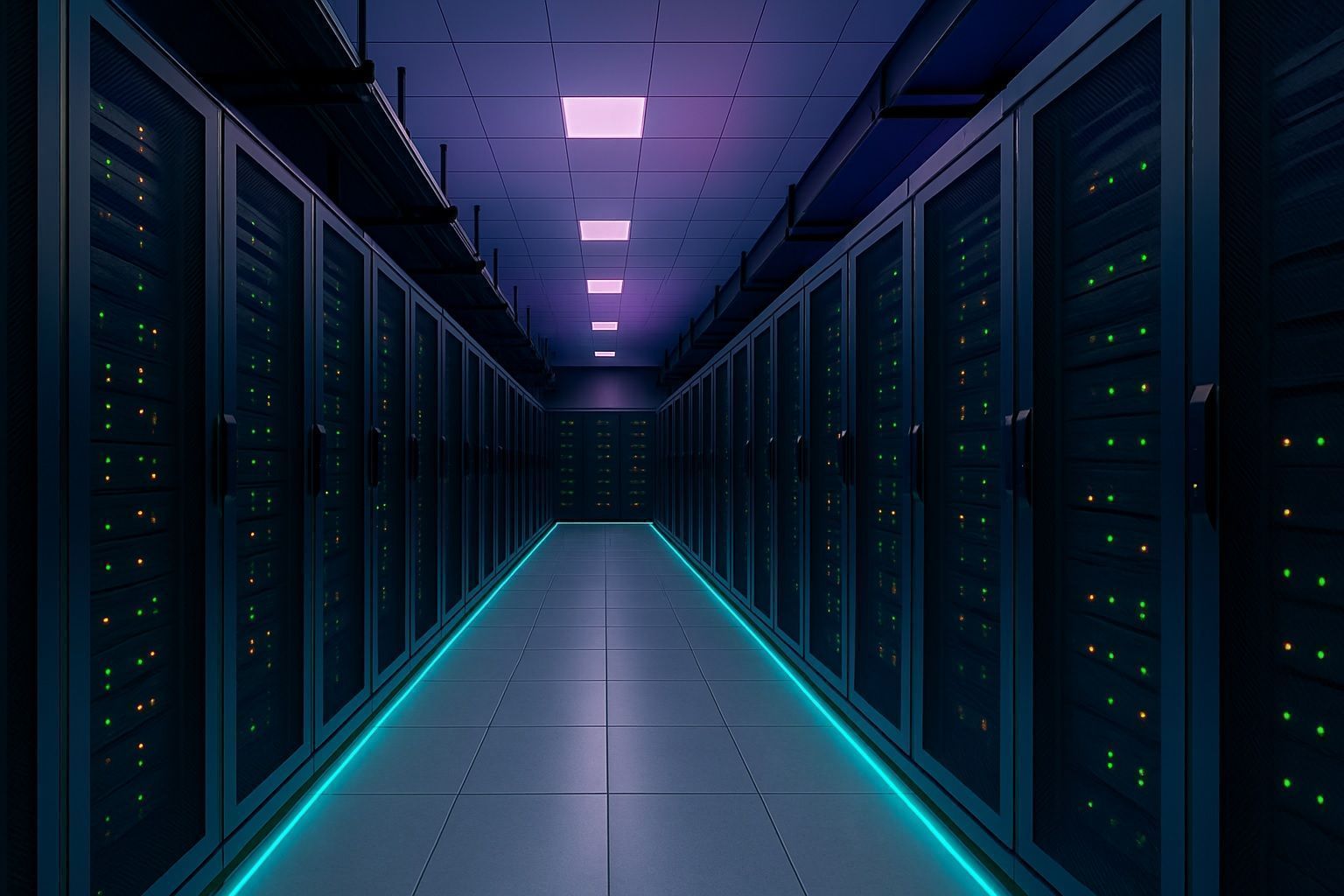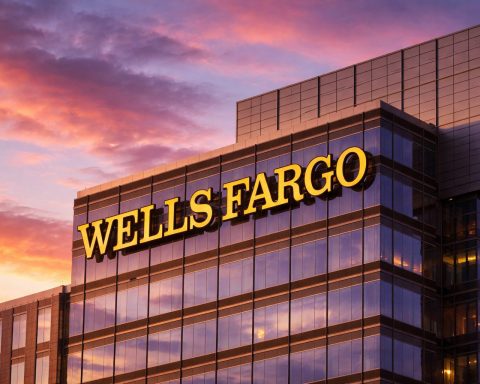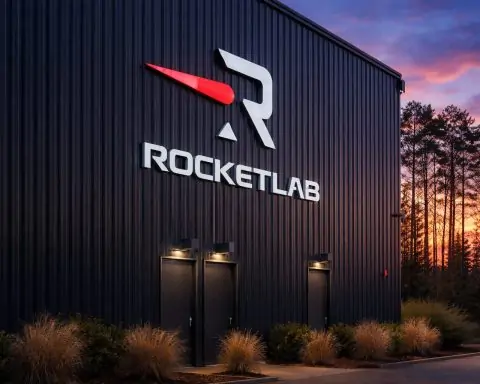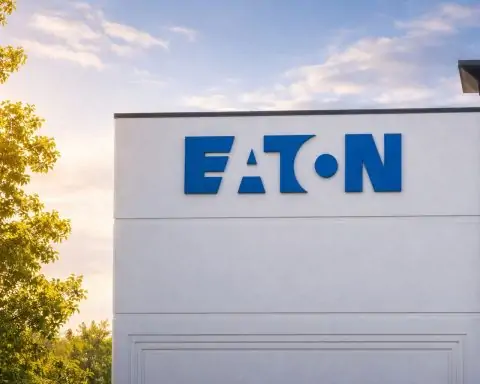- In 2025, Amazon Web Services announced a $10 billion investment in North Carolina to build an AI-focused data center campus in Richmond County, creating 500 jobs.
- AWS plans new data centers in Chile, New Zealand, Saudi Arabia, and Taiwan, with CEO Matt Garman calling the expansion pace “breakneck” to support AI workloads.
- Alibaba Cloud opened its second data center in South Korea in June 2025 and pledged $52.7 billion to build a unified global network, adding a new region in Mexico and a second site in Thailand this year.
- Equinix completed the acquisition of three Manila, Philippines data centers (MN1, MN2, MN3) on June 4, 2025, adding capacity for 1,000+ cabinets.
- CyrusOne unveiled a 90 MW sixth UK campus (LON6) in Buckinghamshire, west of London, on June 13, 2025, featuring on-site solar panels covering 64% of office power.
- NTT Global Data Centers committed over $10 billion through 2027 to expand its footprint, acquiring land in Hillsboro (216 MW expansion to 354 MW total), Phoenix (174-acre campus for seven data centers and 324 MW), Milan (53 acres for a 128 MW campus), Frankfurt (80 MW), London (26 acres), Tochigi for two 50 MW centers, and Osaka for two 36 MW centers.
- TikTok announced a €1 billion data center in Finland as part of Project Clover to localize EU user data.
- OpenAI partnered with UAE’s G42 to develop a 5 GW AI data center cluster in Abu Dhabi, signaling a major regional AI infrastructure push.
- Vantage Data Centers completed the industry’s first euro-denominated ABS in June 2025—a $731 million (€640 million) securitization of six leased European data centers in Germany.
- In Nevada, Redwood Materials and Crusoe Energy deployed the world’s largest data center powered by recycled EV batteries—a 12 MW / 63 MWh battery system with on-site solar, touted as the largest behind-the-meter microgrid in North America.
Surge in Data Center Construction & Expansion Projects
Hyperscalers Double Down on Capacity: Cloud giants are racing to build new facilities worldwide to meet soaring AI and cloud demand. Amazon Web Services (AWS) announced a $10 billion investment in North Carolina to develop an AI-focused data center campus (Richmond County), creating 500 jobs [1] [2]. “Amazon’s $10 billion investment in North Carolina underscores our commitment to driving innovation and advancing the future of cloud computing and AI,” said David Zapolsky, Amazon’s Chief Global Affairs Officer [3]. AWS is also expanding globally – with plans for new data centers in Chile, New Zealand, Saudi Arabia, and Taiwan – as CEO Matt Garman confirmed the company’s “breakneck” expansion pace to support AI workloads [4]. Similarly, Alibaba Cloud launched its second data center in South Korea in June 2025 to provide “more resilient and adaptable cloud environments…fostering AI innovation” amid surging local demand [5] [6]. The Chinese cloud provider’s CEO pledged $52.7 billion to build a unified global network, already adding a new region in Mexico and a second Thailand site this year [7].
Colocation & Telecom Operators Expanding: Leading data center operators are constructing massive new campuses across key markets. On June 4, 2025, Equinix completed the acquisition of three carrier-neutral data centers in Manila, Philippines, marking its entry into that country [8]. The facilities (MN1, MN2, MN3) offer capacity for 1,000+ cabinets and already host major networks and exchanges [9] [10]. “This expansion is instrumental in fostering interconnection, enabling our customers and partners to scale seamlessly within one of the region’s most dynamic digital economies,” said Equinix’s Asia-Pacific president Cyrus Adaggra [11]. In Europe, CyrusOne unveiled plans for a sixth UK campus (LON6) in Buckinghamshire – a 90 MW data center complex west of London [12] [13]. “This development marks an important step in our European growth… As demand for digital services accelerates, larger facilities are necessary to provide economies of scale while ensuring resiliency,” said Matt Pullen, CyrusOne’s EVP for Europe, on June 13, 2025 [14]. The campus will feature on-site solar panels (covering 64% of office power) and green roofs to blend into the landscape [15]. Meanwhile, NTT Ltd. (NTT Global Data Centers) is aggressively expanding across continents – acquiring land in seven markets (Hillsboro, Phoenix, London, Frankfurt, Milan, Osaka, and Tochigi) to support nearly 1 GW of new capacity [16] [17]. This strategic land bank will enable NTT to build major campuses, including a 128 MW site in Milan (its first in Italy) and 100 MW across two planned centers near Tokyo [18] [19]. “By bringing new capacity to high-growth regions, we’re building the foundation enterprises need to innovate and scale confidently in an AI-driven economy,” said Doug Adams, CEO of NTT GDC, adding that the company is investing ahead of demand to deliver “resilient, sustainable infrastructure” for customers [20] [21]. Other notable builds include TikTok’s announcement of a €1 billion data center in Finland (part of its Project Clover initiative to localize EU user data) [22], a €3 billion campus outside Milan planned by Apto – set to be Italy’s largest [23] – and a French consortium (MGX, NVIDIA, etc.) coordinating on Europe’s largest AI-focused campus in France, described as “transformational” for the region [24]. Even emerging markets are seeing big projects: in India, a local firm announced a 100 MW “AI-powered green data center” for Hyderabad [25], and in Malaysia, construction has begun on a 256 MW campus (Vantage’s Cyberjaya II) to meet regional cloud and AI growth [26].
Colocation Market Growth and Demand Trends
Demand for data center space is reaching record highs in 2025, driven by cloud and artificial intelligence needs. In Europe, colocation take-up is on track to hit 855 MW this year, a 22% year-over-year increase (up from 699 MW in 2024) – the fastest growth in four years [27]. CBRE reported on May 27, 2025 that this would set an all-time record, with London and Frankfurt alone accounting for 46% of the demand [28] [29]. “We expect a buoyant year of take-up… Hyperscaler and AI requirements have led to greater demand that will manifest in record take-up,” said Kevin Restivo, CBRE’s Head of European Data Center Research [30]. Notably, demand is outpacing supply for the third straight year, as providers struggle to secure enough power and land to keep up [31]. This appetite for capacity persists despite local constraints, leading to ever-larger wholesale facilities (often single-tenant builds for hyperscalers) being planned across Europe [32].
Globally, hyperscale operators are now the dominant force in infrastructure. New Q1 2025 data from Synergy Research shows hyperscale firms operate 1,189 large data centers worldwide and account for 44% of all installed data center capacity [33]. Non-hyperscale colocation providers contribute another ~22%, while on-premises enterprise data centers – once the majority – have fallen to ~34% of capacity [34]. (Just six years ago, on-premise was 56%.) Synergy projects that by 2030, hyperscalers (like AWS, Microsoft, Google, Alibaba, etc.) will control 61% of global capacity, whereas on-prem facilities will shrink to ~22% [35] [36]. Colocation capacity will keep rising each year (near double-digit growth), but its share of the total may slowly decline as cloud platforms build more of their own mega-facilities [37]. “Cloud and other digital services have been the prime drivers behind data center expansion, and the rise of AI is now providing added impetus,” observed John Dinsdale, Chief Analyst at Synergy. He noted that all regions are seeing double-digit growth in capacity, although the mix varies (hyperscale-owned capacity is more prevalent in the US than EMEA or APAC) [38]. In the Asia-Pacific, for example, growth is not just about AI – local factors are fueling construction booms in specific markets. Malaysia has transformed from a spillover location to a primary data center hub thanks to government support and land availability, Thailand is activating new builds following major cloud commitments (e.g. AWS and Google investing in Thai cloud regions), and Japan continues to grow despite physical constraints and high costs in Tokyo [39] [40]. According to a July 2, 2025 analysis in Data Center Knowledge, these three nations (Malaysia, Thailand, Japan) are poised to lead APAC data center expansion through 2030, underscoring how emerging markets and edge locations are rising to prominence alongside traditional hubs [41] [42].
Another trend is the record-low vacancy rates and tight capacity in many top metros. Industry reports have noted that in major U.S. hubs like Northern Virginia and Silicon Valley, vacancy for wholesale colocation fell to historic lows in 2024–2025, putting upward pressure on prices and spurring development in secondary markets [43] [44]. Despite challenges, the “appetite for capacity continues to surge” in 2025, led by hyperscalers and AI startups, even in the face of power and land shortages [45]. In short, demand for data center infrastructure is robust and accelerating into 2H 2025, with AI computing needs emerging as a key driver everywhere.
Moves by Major Industry Players (Equinix, Digital Realty, NTT, CyrusOne, etc.)
Equinix: The world’s largest colocation operator continued its global expansion strategy. In early June, Equinix closed the strategic acquisition of 3 Manila data centers from Philippines-based Total Information Management, extending Platform Equinix into a new country [46]. The three facilities (now Equinix MN1, MN2, MN3) immediately add capacity for local and international customers looking to expand in the Philippines’ fast-growing digital economy [47] [48]. Equinix noted the sites already host key network providers and internet exchanges, which will bolster its interconnection ecosystem. With partnerships like those with NVIDIA and HPE, Equinix said entering the Philippines will help local firms tap into a global cloud and AI ecosystem of over 10,000 participants [49]. Equinix’s next target in Asia is Thailand – the company has a $500 million investment plan underway to establish a presence in Bangkok, reflecting an aggressive push into ASEAN markets beyond its core in Singapore [50]. Additionally, Equinix hosted an Analyst Day in late June 2025 to outline its long-term strategy, highlighting trends such as xScale hyperscale sites and its leadership in sustainable energy procurement [51] [52] (Equinix aims for climate-neutral operations by 2030).
Digital Realty (DLR): Digital Realty, which operates 300+ data centers worldwide, has been focusing on future-proofing its facilities for AI while keeping sustainability in check. In a June 4, 2025 Business Insider interview, Digital Realty executives discussed scaling up infrastructure to support AI workloads and high-density cooling. They noted data centers already consume ~1.5% of global electricity (per 2024 IEA data), a figure that could nearly double by 2030 – approaching the annual energy use of a country like Japan [53]. Cooling is another challenge: some AI superclusters can guzzle millions of gallons of water per day for cooling, raising concerns in water-stressed regions [54]. DLR’s VP of Sustainability Aaron Binkley said the company is responding by sourcing more renewables, upgrading to ultra-efficient cooling (including exploring liquid and immersion cooling), and rethinking site selection to avoid resource bottlenecks [55]. In terms of growth, Digital Realty has a number of expansions in progress: it recently opened new data halls in Paris and Frankfurt, is building out capacity in Dallas (albeit with a downsized upgrade due to unforeseen constraints [56]), and its joint venture in India (with Brookfield) is developing mega-campuses in Chennai and Mumbai. Digital Realty also made news by adopting HPE’s private cloud platform across its data centers to better manage and automate operations [57]. This move will help DLR offer more XaaS and edge computing solutions on its colocation platform. The company’s leadership emphasizes balancing rapid growth with sustainability: “Collaboration is key to meeting business and climate goals – we’re integrating design, engineering and sustainability teams to support AI growth responsibly,” Binkley told Business Insider [58].
NTT Ltd.: NTT’s Global Data Centers unit (formerly RagingWire/NTT Communications DCs) is in the midst of a major expansion spree. In 2025, NTT committed over $10 billion through 2027 to grow its data center footprint globally [59]. In the past six months, it acquired large land parcels in North America, Europe, and APAC for new campuses totaling nearly 1 gigawatt [60] [61]. Notable projects include a 216 MW expansion in Hillsboro, Oregon (bringing that campus to 354 MW) and a new 174-acre campus in Phoenix, Arizona planned for seven data centers and 324 MW [62] [63]. Internationally, NTT is entering Milan, Italy with a 53-acre site (for a 128 MW campus) and adding a fifth campus in Frankfurt (80 MW) [64]. In London, it bought 26 acres for its eighth data center and even secured freehold rights to its existing sites to enable future growth [65] [66]. In Japan, NTT purchased land in Tochigi (near Tokyo) to build two 50 MW data centers, and in Osaka for two more facilities (36 MW) [67] [68]. These expansions will cement NTT as one of the top-three global data center operators. Doug Adams, NTT’s Global Data Centers CEO, stated that with backing from NTT Corp, they can “invest proactively, ahead of market demand… delivering the resilient, sustainable infrastructure clients need while staying ahead of industry shifts.” [69] NTT is also pursuing strategic partnerships – for example, in India it signed an MoU with the Telangana state government and a local firm to develop a 400 MW data center cluster in Hyderabad aimed at AI workloads [70] [71]. Additionally, NTT Corp. streamlined its business by taking its IT services arm NTT Data private (in a $16.4 billion deal) in 2025 [72], which could augment synergies between its network, cloud, and data center services.
CyrusOne: CyrusOne (owned by KKR/GIP) has been actively growing in both the U.S. and Europe. Alongside the new UK campus (90 MW in Greater London) announced in June [73] [74], CyrusOne is expanding its footprint in Frankfurt, Dallas, and the New York metro. The company also made headlines on July 2, 2025 by partnering with E.ON, a major European utility, to tackle power grid constraints that have been slowing data center growth in Frankfurt [75] [76]. This strategic partnership will develop on-site local power generation solutions for CyrusOne’s facilities – the first project will add 61 MW of capacity to its Frankfurt (FRA7) site by 2029 via a dedicated energy center [77]. CyrusOne’s European MD Matthew Pullen said the alliance gives customers “a runway to large-scale growth without utility risk… a replicable model for future data centres” that integrates advanced energy technology [78]. In the U.S., CyrusOne has a dozen new builds underway; it recently topped out construction of an 18 MW data center in Aurora, Illinois, and in April broke ground on a large campus in Fort Worth, Texas [79] [80]. The firm is also eyeing acquisitions in under-served markets and emphasizing sustainability (aiming for 100% renewable energy and aggressive PUE targets by 2030). Notably, CyrusOne joined other U.S. providers (CloudHQ, CoreWeave, etc.) in a pledge to invest ~$8 billion in UK digital infrastructure after the UK government’s policy shift to ease data center development (see Regulatory section) [81].
Other Players:Vantage Data Centers achieved a financing milestone in June by completing the industry’s first Euro-denominated asset-backed securitization (ABS). The $731 million (€640 M) deal, announced June 9, 2025, securitized six fully leased European data centers (in Germany) [82] [83]. “Issuing the first euro ABS in our sector is a significant milestone… Vantage continues to unlock new funding vehicles to fuel our global expansion,” said Rich Cosgray, Vantage’s SVP of Global Capital Markets [84]. The ABS notes were structured as Green Bonds (with Sustainalytics verification) to fund sustainable development and will help Vantage accelerate new builds in EMEA [85] [86]. Meanwhile, Iron Mountain Data Centers expanded its renewable-powered campus in Amsterdam, breaking ground on a 10 MW expansion of AMS-1 that will run entirely on green energy [87] [88]. In Asia, Microsoft opened its first Indonesian cloud region in Jakarta (June 2025) to serve the booming market [89], and Google awarded a $237 M construction contract to build out its new data center in Malaysia as part of a $2 B investment there [90] [91]. Alibaba Cloud not only expanded in Korea (as noted) but also launched new AI cloud services in Malaysia and the Philippines [92] [93]. Finally, OpenAI – best known for ChatGPT – is emerging as a cloud investor: it announced a partnership with UAE’s G42 to develop a 5 GW AI data center cluster in Abu Dhabi, which would be one of the world’s largest AI computing sites [94]. This bold move signals how even non-traditional players (in this case, an AI research company) are investing in infrastructure, often in collaboration with regional partners, to secure the capacity needed for next-gen AI models.
Strategic Investments, M&A and Partnerships
June–July 2025 saw a flurry of strategic deals as companies position for growth. Mergers & Acquisitions: In addition to Equinix’s Manila deal, Blackstone-backed Phoenix Data Center LLC acquired land in Arizona to attract a hyperscale builder – notably, investor Chamath Palihapitiya put in $51 million for 1,500 acres west of Phoenix aiming to create a 1,500 MW data center campus [95] [96]. In Asia, Macquarie Asset Management agreed to acquire a major data center in Seoul (the 24 MW Hanam facility) for approximately $530 million, expanding its portfolio in the high-demand Korean market [97] [98]. And in Latin America, Cirion (formerly CenturyLink’s LATAM unit) purchased land to expand its Rio de Janeiro campus, planning a new 60 MW facility (RIO2) to meet regional demand [99] [100].
Joint Ventures & Investments: A standout announcement was the $15 billion joint venture between Crusoe, Blue Owl Capital, and Primary Digital Infrastructure – which in June entered its second phase to fund a 1.2 GW data center project in Texas [101] [102]. Construction is already underway in Abilene, TX on six buildings due by next year [103]. Similarly, in Saudi Arabia, local firm DataVolt signed an MoU with Supermicro (a server manufacturer) to jointly build hyperscale AI campuses in the Middle East, starting in NEOM, KSA [104]. This partnership will see Supermicro supply ultra-dense GPU systems for new “green” AI data centers in the region [105]. Another East-West alliance is OpenAI’s partnership with Microsoft and now Google Cloud: in late June it emerged OpenAI will tap Google Cloud for additional capacity, even as Microsoft remains its primary cloud partner [106] [107]. OpenAI also forged deals with Oracle and CoreWeave to diversify its compute infrastructure [108] – a response to the insatiable GPU/AI compute needs that outstrip a single provider’s capacity.
On the sustainability front, CyrusOne’s partnership with E.ON (mentioned above) represents a strategic investment in on-site power generation to overcome grid bottlenecks [109] [110]. Likewise, Meta (Facebook) invested in renewable energy projects: in June, construction began on Arevon Energy’s 430 MW Kelso solar farms in Missouri, dedicated to powering Meta’s data centers through a long-term PPA [111]. And in a novel twist, Redwood Materials (a battery recycling startup founded by ex-Tesla CTO JB Straubel) partnered with Crusoe Energy to deploy the world’s largest data center powered by recycled EV batteries [112] [113]. The pilot project in Nevada uses a 12 MW/63 MWh battery system – hundreds of repurposed EV battery packs – plus on-site solar to run a 2,000-GPU compute cluster for Crusoe (an AI cloud provider) [114] [115]. Straubel said they’re “aiming at projects 20 to 100 times larger” in future deployments as this energy storage solution proves viable [116]. This kind of innovative partnership blurs the line between data center and energy infrastructure investment.
Overall, investment activity remains strong, from private equity funding and real estate deals to joint ventures focusing on emerging markets (e.g. BlackRock’s tie-up with Thailand’s CP Group and TrueIDC to grow Thai digital infrastructure [117]) and new technologies (like Dell’s June launch of on-premises “AI Factory” modular data centers for enterprise AI needs [118]). The continued influx of capital and creative deal-making underscores confidence in the data center sector’s growth trajectory through 2025 and beyond.
Innovations in Sustainability and Energy-Efficient Infrastructure
Power and cooling constraints have become critical issues as data centers scale up, spurring innovative solutions in June–July 2025. Energy Reuse & On-Site Generation: In Frankfurt – Europe’s busiest data center hub – the electric grid’s capacity is nearly tapped out, causing multi-year delays for new connections [119] [120]. To address this, CyrusOne partnered with utility E.ON to develop local gas-fired generation and potentially waste-heat reuse for its campus. The first E.ON “IQ Energy Center” will add 61 MW of supplemental power by 2029 to CyrusOne’s Frankfurt-GRIESheim site, enabling an extra 45 MW of IT load (bringing that campus to 126 MW total) without waiting on the public grid [121]. CyrusOne’s Matt Pullen noted this gives customers room to grow “without utility risk… a unique opportunity that sets new industry standards for integrating advanced energy solutions” in data centers [122]. The project will also include absorption chillers to convert generator waste heat into cooling for the facility, and surplus heat may be provided to the surrounding mixed-use development – a model of circular energy use [123] [124]. Similarly, in the Netherlands, operators like Iron Mountain are using 100% renewable power and exploring heat export to communities (Iron Mountain’s expanded AMS-1 facility will feed its waste heat into Amsterdam’s grid) [125]. And in Singapore, where new data centers must meet strict efficiency criteria, firms are adopting liquid cooling and higher temperature set-points to reduce chilled water usage, according to industry reports.
Battery Innovations: A groundbreaking project went live in Nevada in late June – Redwood Materials deployed a giant battery storage microgrid made of second-life EV batteries to power a data center for Crusoe [126] [127]. This is the largest globally known deployment of repurposed EV batteries for backup/primary power. The 12 MW system (63 MWh storage) uses hundreds of retired electric car battery packs that still have usable capacity [128]. Coupled with on-site solar panels, the setup can support ~9,000 homes’ worth of load and is billed as the largest behind-the-meter microgrid in North America [129] [130]. “Think of this almost like a retirement home for these batteries,” said Redwood’s Chief Commercial Officer, noting the reused packs cost about half of new lithium-ion units while delivering the same performance [131]. By giving EV batteries a second life as stationary storage (where demands are gentler than in vehicles), this approach both diverts waste and provides clean energy buffering for data centers. The project’s success could herald wider use of battery energy storage systems (BESS) to help data centers draw more on renewable power and reduce reliance on diesel generators [132] [133]. Indeed, a BloombergNEF report found data centers accounted for ~1.4% of global electricity use in 2024 [134], and operators are keen to curb grid stress and emissions by adding on-site solar, storage, and fuel cells. (Notably, Microsoft is testing hydrogen fuel cells in generator replacement roles, and Equinix is piloting both fuel cells and flow batteries at select sites, according to company sustainability disclosures.)
Water & Cooling Efficiency: The surge in AI computing has heightened focus on water usage. A June 2025 investigative report revealed that 40% of U.S. data centers are located in areas of high or extreme water stress, raising alarms about the sustainability of traditional cooling methods [135]. Some large AI data centers can consume millions of gallons of water per day for evaporative cooling – equivalent to the water supply for tens of thousands of homes [136]. This has been a wake-up call: “It’s a sobering look at sustainability,” wrote Business Insider, noting that as AI heats up servers, it’s also heating up the debate on resource usage [137]. In response, many operators are shifting to alternatives like liquid cooling (immersing servers in coolant or using cold plate technology) which can drastically cut water and power usage for cooling. Data center designers are also experimenting with air-cooled AI pods, heat re-circulation, and deploying facilities in colder climates or near ample water sources to mitigate impact. Some forward-looking innovations highlighted recently include: wooden server racks and even prototype wooden data center structures (to lower embedded carbon) [138], and AI-designed data center blueprints that optimize airflow and energy distribution more efficiently than traditional designs [139]. While these are nascent ideas, they indicate the industry’s drive to innovate for sustainability. Importantly, hyperscalers and colocation firms alike are increasingly tying executive compensation or project approvals to PUE (Power Usage Effectiveness) and WUE (Water Usage Effectiveness) targets – signaling that energy efficiency is now a top-tier KPI in data center development.
Regulatory & Geopolitical Impacts on Data Centers
Government policies and geopolitical events in mid-2025 are significantly influencing where and how data centers operate:
- Easing of Restrictions in Europe: In the UK, the change of government in 2024 led to a loosening of planning rules for building on Green Belt land around London – a move aimed at encouraging digital infrastructure growth [140]. By October 2024, authorities announced that four U.S.-based companies (including CyrusOne, CloudHQ, CoreWeave, and ServiceNow) plan to invest a combined £6.3 billion ($8.2 billion) in UK data centers [141]. CyrusOne’s newly approved London-area campus (discussed above) was one of the projects previously stalled by land-use restrictions but greenlit under the relaxed regime. “We look forward to… supporting the Government to establish the UK as a center of excellence in digital services,” CyrusOne’s Matt Pullen said, aligning the expansion with Britain’s policy goals [142] [143]. Ireland, by contrast, has tightened sustainability requirements – notably South Dublin’s council denied Google permission for a new 30,000 m² data center in late 2024 because the application failed to meet strict energy efficiency and carbon mitigation criteria [144]. This reflects a broader regulatory trend in parts of Europe: new data center proposals must often include renewable energy sourcing, heat reuse plans, and even pledges to pause during grid emergencies to win approval. The EU is also discussing a “European Data Centre Regulation” that could impose binding efficiency and reporting standards by 2026 (building on the voluntary Climate Neutral Data Centre Pact).
- Data Sovereignty and Localization: Geopolitical concerns over data security continue to drive infrastructure decisions. A prime example is TikTok’s €12 billion Project Clover in Europe, which saw TikTok commit to building three European data centers to house EU user data domestically [145]. In June, TikTok confirmed a new €1 billion center in Finland (to be built by local developer Hyperco) as part of this initiative [146]. The facility will store European users’ data and will be monitored by an independent cybersecurity firm (NCC Group) to address regulators’ fears about data access from abroad [147]. Similarly, in India, stringent data localization rules and a booming digital economy have led global cloud players to partner with local firms for new in-country regions – recent months saw Oracle Cloud open dual India zones, and NTT and Adani Enterprises accelerate joint data center projects in Mumbai. These moves show how government policies (privacy laws, digital sovereignty agendas) are directly spurring the construction of regional data centers.
- Middle East Investment and Geopolitics: The Middle East has emerged as a hotspot for large-scale projects thanks to government support and strategic location. Abu Dhabi, UAE in particular is positioning itself as an AI and cloud hub. In July 2025, Abu Dhabi sovereign-backed G42 and OpenAI revealed plans to build a 5 GW data center cluster – the largest ever announced in the region [148]. This comes as Gulf states court Western tech firms; notably, industry insiders speculated that an OpenAI–G42 deal might coincide with high-level diplomatic visits [149]. The project aligns with the UAE’s ambitions to diversify into tech and AI, leveraging its abundant land, capital, and energy (including solar) to attract data center investment. On the flip side, U.S.–China tech tensions are affecting data center supply chains (e.g. export controls on advanced chips needed for AI data centers) and raising questions about Chinese cloud providers’ expansion. Alibaba Cloud’s focus on Asia-Pacific growth (instead of U.S. or Europe) reflects in part a cautious geopolitical climate for Chinese firms. However, Chinese operators are deeply investing in markets like Indonesia, Malaysia, and Saudi Arabia – often with host country support. For example, Saudi Arabia has partnered with Huawei for multiple new data centers as part of its Vision 2030 initiative, despite U.S. concerns, underlining a diversification of global tech alignments.
- Local Incentives and Power Infrastructure: Many U.S. states and other countries are offering incentives for data center projects, viewing them as drivers of jobs and investment. North Carolina’s generous tax breaks for data centers (and readily available land) helped land Amazon’s $10B campus [150] [151]. In contrast, states like Oregon and Virginia are examining new regulations on data center energy use and noise after public pushback in some communities. For instance, Loudoun County, VA (the world’s largest data center hub) is considering tighter rules on diesel generator emissions and backing-up critical infrastructure in response to community concerns and a high-profile outage in 2023. Power availability is another regulatory factor: in Amsterdam and Frankfurt, authorities temporarily paused new data center permits in recent years until grid upgrades were planned. Now, grid access has become a competitive factor – companies like CyrusOne (with E.ON) or Google (investing in private substations) that can secure their own power sources gain an edge in securing approvals and timelines.
In summary, government actions in 2025 are both enabling and constraining data center growth. Regions that streamline permits and invest in utilities (like parts of the U.S. South, Middle East, and Southeast Asia) are seeing a boom in projects, while areas imposing sustainability or capacity checks (Northwest Europe, some U.S. cities) are forcing operators to innovate or slow down. Industry leaders are engaging with policymakers to shape balanced rules – for example, data center coalitions in the EU are lobbying for workable energy efficiency standards instead of hard caps on new construction. The coming months will likely see further clarity on these regulatory fronts, with the shared goal of ensuring data infrastructure can expand to meet digital demand responsibly and securely.
Expert Outlook and Industry Commentary
Industry thought leaders remain bullish on the sector’s prospects, while cognizant of challenges. Analysts’ Forecasts: “The data center space isn’t slowing down anytime soon,” noted a June 27 report by XYZ Reality, citing how even a summer lull hasn’t materialized [152] [153]. That roundup highlighted record leasing in Europe (via CBRE’s data) and major financing wins like Vantage’s securitization as signs of a maturing industry adapting to massive AI-era needs [154] [155]. Wall Street analysts also project robust growth – Raymond James, for instance, in late June raised revenue estimates for Equinix and Digital Realty, pointing to unprecedented hyperscaler orders and enterprise hybrid-cloud growth driving colocation uptake. Synergy Research Group observed that total global IT load is set to triple by 2030, largely on the back of cloud and AI – a wave that will lift both hyperscalers and colo providers (even if the mix shifts) [156] [157].
Executive Insights: Data center CEOs speak of a new era of scale and collaboration. Equinix CEO Charles Meyers, at the June 25 Analyst Day, emphasized the importance of ecosystems: “Interconnection is the backbone – AI doesn’t happen in isolation. We’re investing in not just facilities, but the connectivity and partnerships to support AI workloads globally,” he said (per reporting by SiliconANGLE, June 2025). Gary Wojtaszek, former CyrusOne CEO, commented at a July conference that the current investment cycle is “unlike any before – the AI revolution is compressing 5–10 years of data center demand into 2–3 years”, calling it a “land grab” for capacity in key locations (quote reported by DCD, Jul 2025). At the same time, sustainability was a recurring theme in thought-leadership pieces: Uptime Institute’s COO Chris Brown warned in a June webinar that water usage and carbon emissions could become the “Achilles’ heel” of the industry if not managed, urging designers to adopt advanced cooling and participate in renewable energy grids. This echoed the Business Insider interview where Digital Realty’s team stressed internal cross-discipline collaboration (engineering with sustainability with operations) to meet both business and environmental goals [158].
Looking ahead, experts expect continued consolidation and specialization. Data Center Knowledge noted that more telecom and IT firms are spinning off or selling data center assets to specialist operators or infrastructure funds (e.g. recent rumors of Verizon exploring a data center sale, following AT&T’s 2024 colocation divestiture). The capital intensity and skill required for modern facilities – especially AI-ready, ultra-efficient designs – favor large global players and innovative newcomers backed by significant capital. Nonetheless, regional niches (edge data centers, sovereign cloud data centers) are emerging as growth sub-sectors. CBRE’s mid-2025 outlook concluded on an upbeat note: “Data centers form the backbone of cloud and AI infrastructure… the colocation market is poised for continued heady growth” [159]. With AI adoption, 5G, and Industry 4.0 all accelerating, the consensus is that the demand for well-operated, sustainable data centers will remain on a strong upward trajectory.
Sources: Key information in this report is drawn from recent industry news and analyses, including Data Center Knowledge (June–July 2025), DataCenterDynamics (DCD), Light Reading, Business Insider, press releases from companies and government officials, and expert commentary from research firms like Synergy and CBRE. All source citations (with dates and publications) are provided inline.
References
1. governor.nc.gov, 2. governor.nc.gov, 3. governor.nc.gov, 4. www.datacenterknowledge.com, 5. www.datacenterdynamics.com, 6. www.datacenterdynamics.com, 7. www.datacenterdynamics.com, 8. www.lightreading.com, 9. www.lightreading.com, 10. www.lightreading.com, 11. www.lightreading.com, 12. www.datacenterdynamics.com, 13. www.datacenterdynamics.com, 14. www.datacenterdynamics.com, 15. www.datacenterdynamics.com, 16. www.datacenterdynamics.com, 17. www.datacenterdynamics.com, 18. www.datacenterdynamics.com, 19. www.datacenterdynamics.com, 20. www.datacenterdynamics.com, 21. www.datacenterdynamics.com, 22. www.datacenterknowledge.com, 23. www.datacenterknowledge.com, 24. www.datacenterknowledge.com, 25. www.datacenterknowledge.com, 26. www.datacenterknowledge.com, 27. www.cbre.co.uk, 28. www.cbre.co.uk, 29. www.cbre.co.uk, 30. www.cbre.co.uk, 31. www.cbre.co.uk, 32. www.cbre.co.uk, 33. www.srgresearch.com, 34. www.srgresearch.com, 35. www.srgresearch.com, 36. www.srgresearch.com, 37. www.srgresearch.com, 38. www.srgresearch.com, 39. www.datacenterknowledge.com, 40. www.datacenterknowledge.com, 41. www.datacenterknowledge.com, 42. www.datacenterknowledge.com, 43. www.datacenterknowledge.com, 44. www.datacenterknowledge.com, 45. www.xyzreality.com, 46. www.lightreading.com, 47. www.lightreading.com, 48. www.lightreading.com, 49. www.lightreading.com, 50. www.lightreading.com, 51. www.equinix.com, 52. datacentremagazine.com, 53. www.businessinsider.com, 54. www.businessinsider.com, 55. www.businessinsider.com, 56. www.datacenterdynamics.com, 57. www.datacenterdynamics.com, 58. www.businessinsider.com, 59. www.datacenterdynamics.com, 60. www.datacenterdynamics.com, 61. www.datacenterdynamics.com, 62. www.datacenterdynamics.com, 63. www.datacenterdynamics.com, 64. www.datacenterdynamics.com, 65. www.datacenterdynamics.com, 66. www.datacenterdynamics.com, 67. www.datacenterdynamics.com, 68. www.datacenterdynamics.com, 69. www.datacenterdynamics.com, 70. www.datacenterknowledge.com, 71. www.datacenterknowledge.com, 72. www.financierworldwide.com, 73. www.datacenterdynamics.com, 74. www.datacenterdynamics.com, 75. dcnnmagazine.com, 76. dcnnmagazine.com, 77. dcnnmagazine.com, 78. dcnnmagazine.com, 79. www.datacenterdynamics.com, 80. www.cyrusone.com, 81. www.datacenterdynamics.com, 82. vantage-dc.com, 83. vantage-dc.com, 84. vantage-dc.com, 85. vantage-dc.com, 86. vantage-dc.com, 87. www.datacenterknowledge.com, 88. www.datacenterknowledge.com, 89. www.datacenterknowledge.com, 90. www.datacenterknowledge.com, 91. www.datacenterknowledge.com, 92. www.datacenterknowledge.com, 93. www.datacenterknowledge.com, 94. www.datacenterknowledge.com, 95. www.datacenterknowledge.com, 96. www.datacenterknowledge.com, 97. www.datacenterknowledge.com, 98. www.datacenterknowledge.com, 99. www.datacenterknowledge.com, 100. www.datacenterknowledge.com, 101. www.datacenterknowledge.com, 102. www.datacenterknowledge.com, 103. www.datacenterknowledge.com, 104. www.datacenterknowledge.com, 105. www.datacenterknowledge.com, 106. www.xyzreality.com, 107. www.xyzreality.com, 108. www.xyzreality.com, 109. dcnnmagazine.com, 110. dcnnmagazine.com, 111. www.datacenterknowledge.com, 112. www.datacenterknowledge.com, 113. www.datacenterknowledge.com, 114. www.datacenterknowledge.com, 115. www.datacenterknowledge.com, 116. www.datacenterknowledge.com, 117. www.datacenterknowledge.com, 118. www.xyzreality.com, 119. www.datacenterknowledge.com, 120. dcnnmagazine.com, 121. dcnnmagazine.com, 122. dcnnmagazine.com, 123. dcnnmagazine.com, 124. dcnnmagazine.com, 125. www.datacenterknowledge.com, 126. www.datacenterknowledge.com, 127. www.datacenterknowledge.com, 128. www.datacenterknowledge.com, 129. www.datacenterknowledge.com, 130. www.datacenterknowledge.com, 131. www.datacenterknowledge.com, 132. www.datacenterknowledge.com, 133. www.datacenterknowledge.com, 134. www.datacenterknowledge.com, 135. www.xyzreality.com, 136. www.businessinsider.com, 137. www.xyzreality.com, 138. www.datacenterknowledge.com, 139. www.datacenterknowledge.com, 140. www.datacenterdynamics.com, 141. www.datacenterdynamics.com, 142. www.datacenterdynamics.com, 143. www.datacenterdynamics.com, 144. www.datacenterknowledge.com, 145. www.datacenterknowledge.com, 146. www.datacenterknowledge.com, 147. www.datacenterknowledge.com, 148. www.datacenterknowledge.com, 149. www.datacenterknowledge.com, 150. governor.nc.gov, 151. governor.nc.gov, 152. www.xyzreality.com, 153. www.xyzreality.com, 154. www.xyzreality.com, 155. www.xyzreality.com, 156. www.srgresearch.com, 157. www.srgresearch.com, 158. www.businessinsider.com, 159. www.cbre.co.uk










